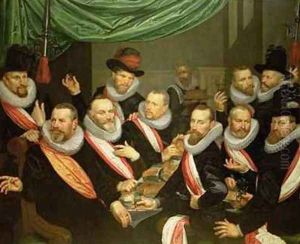Frans de Grebber Paintings
Frans de Grebber was a Dutch painter, draughtsman, and designer, born in Haarlem in the Netherlands in 1573. He was an important figure in the transition from Mannerism to Baroque in Dutch art, and his works often reflected the influence of both styles. De Grebber was part of a family of artists; his father was Pieter Fransz de Grebber, who was a painter and a tapestry designer, and his children Pieter and Maria de Grebber, also became accomplished artists.
Frans de Grebber was trained by his father and later possibly by the Flemish painter Hendrick Goltzius, who resided in Haarlem. He became a member of the Haarlem Guild of Saint Luke in 1597 and later served as the guild's governor multiple times. De Grebber was a Roman Catholic in a predominantly Protestant country, and this influenced his clientele and the subjects of his art. He was known for his religious works and his connections with the court in The Hague, as well as with influential patrons such as the art collector Pieter Claesz van Ruijven.
His style is characterized by a sophisticated use of color and a preference for elegant figures with elongated proportions, which he combined with a growing interest in naturalism and light. His early work showed Mannerist tendencies, while his later works incorporated the more dramatic and realistic styles that were becoming popular in the early 17th century. De Grebber was influential in spreading the Italianate style in the Northern Netherlands and was an early adopter of Caravaggism in Dutch painting.
Frans de Grebber also played a significant role in the development of Haarlem as a center of art in the early 17th century. He was a teacher to many pupils, including his own children and possibly the famous Dutch painter Salomon van Ruysdael. De Grebber's influence extended beyond his immediate circle as he helped disseminate the Baroque style in the region. He died in Haarlem in 1649, leaving behind a body of work that had a lasting impact on the Dutch Golden Age of painting.
